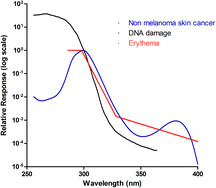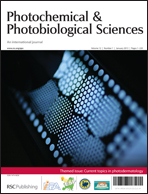Spectral effects of UV on psoriasis†
Abstract
Ultraviolet B (UVB) is a highly effective, relatively safe, affordable and widely used therapeutic option for moderate psoriasis. Several types of UVB lamp are available to treat psoriasis, both broadband and narrowband, allowing a choice of spectral emission. However despite years of clinical use, the mechanism of action of UVB in clearing psoriasis remained incompletely understood. Moreover, there has been little insight into how the relative effectiveness of different UVB wavelengths linked to the mechanism of action, although it is known that the action spectrum for clearance of psoriasis differs from the action spectrum of erythema. This paper examines the existing literature from which our current treatments have evolved, and offers new insight into the use of keratinocyte apoptosis as a

- This article is part of the themed collection: Current topics in photodermatology

 Please wait while we load your content...
Please wait while we load your content...